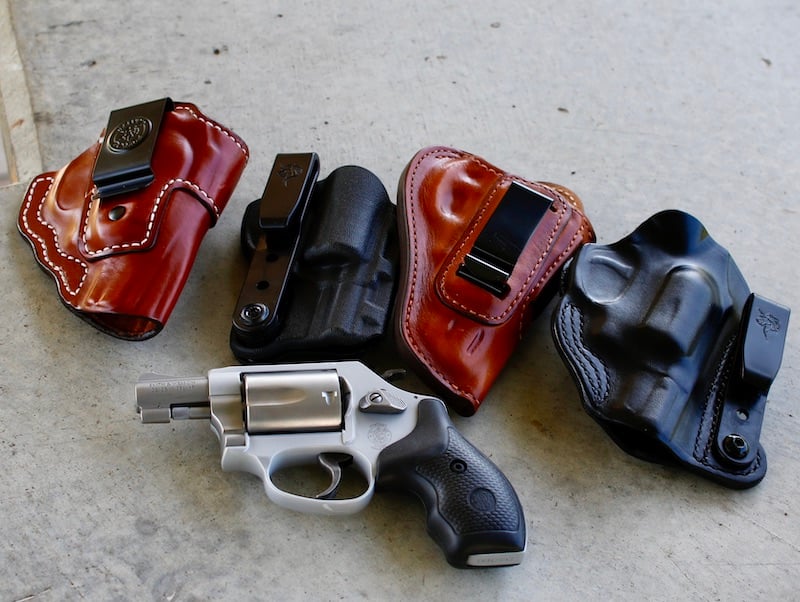Devotees of The Mag Life Blog will know we sometimes get hung up on themes. My latest is a quixotic attempt to find the best way to carry a snub-nosed J-frame revolver. To that end, I’ve been testing outside-the-waistband holsters, pocket holsters, and — the focus of this piece —some new designs for in-waistband carry looking for that perfect way to carry a wheel gun.

The .38 as an EDC Gun
First, I feel compelled to talk a bit about my philosophy on EDC. I’ve been carrying a gun now for 25 years. I train regularly and treat the practice of concealed carry with the solemnity it deserves. Over this period, I’ve carried a couple of 1911s, a Glock 19 (and now a Glock 45). I’ve carried the P365 and the Hellcat. Each of these has its own selling points.
I live in the South and work from home, which means I’m often wearing shorts and a T-shirt. Though I’ve got what some would consider an arsenal within easy reach at all times, I also carry a beat-to-hell Kel-Tec P3AT that fits neatly (holstered) in my front pocket.
For me, capacity is everything. The unique mix of capacity and size offered by the Hellcat and P365s make them both ideal for times when I want the perfect balance, but when I can conceal something larger, and thus easier to control, I’ll default to the G45. So why am I writing about a gun that only holds five rounds of .38?
First, there’s a proven track record. Second, I’m a gun nerd and I really dig well-made mechanical devices — I like how revolvers work and move. Third, this is a gun I know my wife can carry and use effectively. She has always gravitated to the revolver over the automatic.
My father carried a revolver, I learned to shoot on a revolver, and not every everyday scenario requires the lifestyle overhaul necessitated by big guns with extra mags. Some trainers preach about preparing for the worst — all the time — and training with one platform only. As a review writer, I carry what’s and hand and put review guns to the test in EDC, so I mix it up regularly. And I’m completely fine walking into the real world with a J-frame.

In Waistband (IWB)
There are a couple of designs that are common for IWB carry. The old-school leather holsters (most revolver holsters are still made of leather) have the clip on the front of the holster. As someone who works for a holster company, I’m a bit flummoxed by the added bulk to the design.
The best options here have steel clips that are thin. Plastic clips have to be thicker to keep from snapping, even when made of Delrin or nylon. The revolver’s cylinder is its widest part, so adding a clip above that is dubious for those concerned about concealment. Clips can be placed out to the side.

One clip on the side, though, has its drawbacks. A strong draw stroke tends to pull at the point where the clip joins the holster, and the gun and holster, together, can pivot on that fulcrum. I prefer holster clips that are anchored at two points on the same clip, at least, and a tension that will allow the gun to draw cleanly without rocking out the holster.
The alternative, and a rarity for these designs, is a two-clip design. While this is everywhere for semiautos, it is less common for revolvers. The one that comes readily to mind is CrossBreeds wide design.
Revolver holsters have, for a long time now, relied on a traditional look, too. Why so much leather? Is it because many who carry revolvers also carry AARP cards, and leather is what they grew up with? What’s wrong with a Kydex revolver holster?
Here’s a look at some of the new designs for in-waistband carry of revolvers.
DeSantis Gunhide Summer Heat Holster for Smith & Wesson J-Frame

I’ll start with the most traditional design, and the one that is the most intuitive for those new to EDC. The DeSantis Gunhide Summer Heat Holster for Smith & Wesson J-Frame has a solid steel clip and is built like a tank. The reinforced leather design makes this a great holster that will weather exceptionally well and age gracefully. This is the type of holster that you’d pass on to the next generation and it would still be just as solid then as it would be now.
The Summer Heat sells for $38.99.
DeSantis Gunhide Slim-Tuk Holster for Smith & Wesson J-Frame

The next one is the most untraditional of these designs. The DeSantis Gunhide Slim-Tuk Holster for Smith & Wesson J-Frame takes the offset clip concept I discussed earlier and builds it into a thermoformed design that feels much more like the EDC holsters many people use for their micro-compact 9mms.
There are a couple of benefits here worth mentioning. While leather sometimes requires a break-in period, the plastic does not. The revolver snaps into place firmly with a nice audible clack that lets you know the gun is seated properly. Though plastic can be slick, there’s no way to turn the cylinder — not even by cocking the exposed hammer on a revolver, so there’s no difference in the security offered here.
The Slim-Tuk is $27.99, primarily because the material cost is less.
DeSantis Gunhide Flex-Tuk Holster for Smith & Wesson J-Frame Revolvers

The best of both worlds? The DeSantis Gunhide Flex-Tuk Holster for Smith & Wesson J-Frame Revolvers is the one I’ve been carrying most frequently. I really like the feel of leather, but the offset clip keeps some of the exposed bulk down.
The Flex-Tuk and Slim-Tuk both have clips that would allow you to tuck in a shirt behind the clip, but I’ve not tucked in a shirt once this year, and I’m not about to start now. But maybe those of you who have stricter social expectations might find this useful.
The leather on this is decently rigid. I’d guess it was in the 7-8 ounce weight. It isn’t as robust as some of the other leathers in these IWB designs, but the way it is molded is really compelling.
How well will it age? A couple of summers will tell. I would expect it to outlast me in this design, but we don’t have a long track record for how injection-molded plastics stand up to UV light, repeated stress, etc. I guarantee that well-cared-for leather and steel will last longer. That said, I could care less if this isn’t an heirloom design — it works exceptionally well right now, and that’s the most important thing.
The Flex-Tuk is $45.99.
The Bianchi Model 100

This last one is a prototype that I’ve helped design. It should be ready for prime time in the next few weeks.
The concept is simple enough — we took a classic design, something Bianchi does well, and added a bit of modern flexibility. With the help of Radar Holsters (an Italian company that makes exceptional leather holsters), we built an elastic band into the folded leather design. This allows for a number of different revolvers to fit.
A fun fact I discovered recently: not all J-frame frames are the same size. Even in the same caliber, the frame dimensions change when the materials change. Steel frames are slightly smaller than aluminum frames. This makes precision fits hard to nail down. And it is much worse when you look at similarly sized guns from Charter, Ruger, Taurus, Colt… You can easily buy a generic snub-nosed holster that has what I’d consider to be sloppy tolerances. This Bianchi Model 100 will change that and provide some flexibility.
Another element of this design is the rocking motion required to clear the holster. As the gun snaps in, it rocks into place and the trigger guard rolls into place under the leather. If you pull straight up, the draw is really tight. Rock the grip forward slightly — pushing against the elastic edge, and the gun draws easily. This adds an extra element of security to the holster without the need for a thumb snap.
Which one works best?
After working with these for a couple of months, I’m inclined to carry in the Flex-Tuk. For how I tend to carry (appendix), this one works perfectly.
The choices, though, keep getting better. That’s the takeaway here. For so long, IWB holsters for revolvers have been an afterthought, which meant we had to take what we got. Not anymore.


